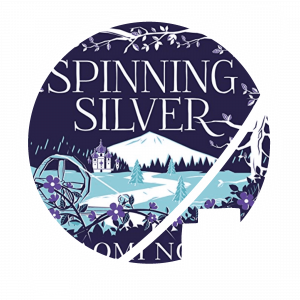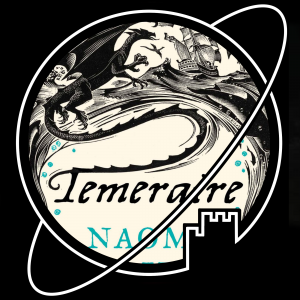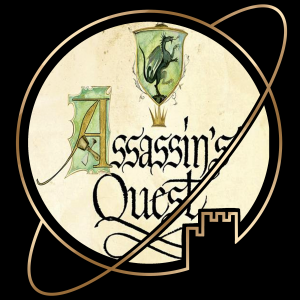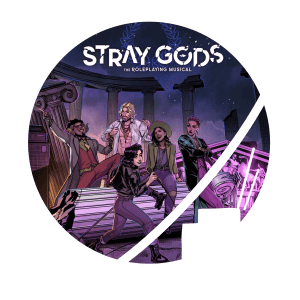- Book written by Naomi Novik
- Published 10 July 2018
- Standalone
Miryem’s father is a moneylender. He is renowned for his kindness, and eventually the family falls into poverty as the townspeople take advantage of his leniency and stop paying back their loans. Eventually, Miryem hardens her heart and starts collecting the debts herself. She becomes known as someone who can spin silver into gold, and attracts the attention of the king of the Staryk, a mythical icy people who terrorise humans. Meanwhile a plain noblewoman tricks the cold-hearted tsar into marrying her, and discovers exactly what evil force has chilled his heart.


Spinning Silver is a stunning fairy tale. Novik manages to capture a certain atmosphere incredibly well. Honestly, it’s hard to describe quite how this book made me feel.
It’s definitely not a short book, but it was well worth the time I spent on it. The ~vibe~ of this book is fantastic. I’d highly recommend reading this in winter, especially if you live in a place where it snows.
One of my favourite things about Spinning Silver were the characters. Everyone seems to have depth, and you really grow to like some of them, even if you strongly disliked them at the start. Novik takes her time with these character developments, and the story never feels rushed.
This book is a retelling of the fairy tale of Rumpelstiltskin. I feel like the genre of fairy tale retellings is a very difficult one to work in, as it’s very easy to come up with “twists” to fairy tales, which means that it’s hard to come up with something original that feels like it stands alone and isn’t just something at the level of Disney’s live action remakes. I honestly really dislike a lot of this genre because I’m not a huge fan of stories that are made “edgy” for the sake of it. Spinning Silver doesn’t fall in this trap. To be honest, I’m not sure I would have recognised it as being inspired by Rumpelstiltskin (because I am dense, but also because it’s not a one to one retelling). The story has its dark moments, but they serve a purpose in the book.
Spinning Silver is what a book should be. You know how sometimes you read a book, and in that book a character is reading a book about far off places and magic and magical creatures? And then you wish you could find a book just like that because it sounds so whimsical and dream-like? Yeah. That’s kind of what Spinning Silver is like.

It’s rare to find books in which characters and plot are skilfully balanced, even more so when the story is told from multiple perspectives. It’s quite extraordinary to find such qualities in a book that also comes with a strong atmosphere and well-developed themes. Imagine my pure delight when I discovered Naomi had craftily managed this with Spinning Silver!
Truly, there’s little to criticize in this book. It has a well built cast of characters whose storylines are cleverly interwoven. Although I can’t say the characters deeply touched me on an emotional level, their struggles and sentiments were very convincing. Furthermore, the female protagonists get to be strong in an authentic way, without the author succumbing to cheap tomboy pitfalls. Especially Miryem hit the mark for me, and I was impressed with the subtle and sensitive way Naomi handled her Jewish heritage.
Another one of Spinning Silver‘s strong points is its mystical atmosphere, strongly defined by elements of (East-)European fairy tales and cultures. The story quickly invoked a sense of wonder in me, not very unsimilar to the way a younger me felt when listening to fairy tales in my youth. If that’s not magical, what is?

I enjoyed Spinning Silver. I am not lyrical about it, but I know some other curators are and I can totally see why. Spinning Silver is awesome at what it tries to do. What it tries to do is just not what I want to read most of the time.
Spinning Silver is a fairytale-esque fantasy novel set in a wintery eastern European medieval setting that is just new enough to entice and just familiar enough to be comfortable. It follows the day to day struggles of three women, each trying to achieve their own goal. Each of our protagonists then gets set on a path towards a confrontation with the magical powers that keep the land shrouded in an unnaturally long winter.
The fairy tale-esque nature of the book means that the worldbuilding is relatively limited and it instead leans heavily on mystery and atmosphere. This, alongside its themes of building confidence, standing up for yourself, and the importance of family, makes it a light read particularly well suited for younger readers.
There is also a subtle red line of antisemitism and the othering of Jews in medieval communities, though it does not have hard edges in this specific book and might actually serve well as a starting point for a conversation about discrimination in modern society.
Personally, I was not blown away. I am not a massive fan of Novik’s writing style in Spinning Silver and Uprooted, which I think is a bit matter-of-fact and – dare I say it? – a bit dull (often, she writes relatively large sections which feel like a chronological observation of a character’s actions more than the telling of a story). I always whish Novik would tell us just a little bit more about the worlds and cities her characters inhabit, which are an original take on the genre and just screaming for more detail. And I wish she would giver her characters just a bit more flavour and individuality. In this book, I felt like two of the three main characters were so similar as to be nearly indistinguishable at times.
That’s a lot of criticism (especially for a book that I enjoyed!), and I understand the criticism is mostly besides the point of the book.
Spinning Silver is about the atmosphere, about coming together to defeat not one but two evils, about spring beating winter, about mystical cabins in the wood and hidden worlds behind a mirror. If that description stirs something inside you, I wholeheartedly recommend you Spinning Silver.
If you, like me, are into fantasy with rough edges, however, this book might not be your favourite read of the year.













